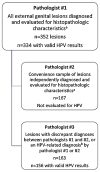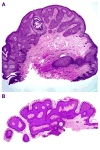Role of histological findings and pathologic diagnosis for detection of human papillomavirus infection in men
- PMID: 25945468
- PMCID: PMC4780420
- DOI: 10.1002/jmv.24238
Role of histological findings and pathologic diagnosis for detection of human papillomavirus infection in men
Abstract
Early HPV infection in males is difficult to detect clinically and pathologically. This study assessed histopathology in diagnosing male genital HPV. External genital lesions (n = 352) were biopsied, diagnosed by a dermatopathologist, and HPV genotyped. A subset (n = 167) was diagnosed independently by a second dermatopathologist and also re-evaluated in detail, tabulating the presence of a set of histopathologic characteristics related to HPV infection. Cases that received discrepant diagnoses or HPV-related diagnoses were evaluated by a third dermatopathologist (n = 163). Across dermatopathologists, three-way concordance was fair (k = 0.30). Pairwise concordance for condyloma was fair to good (k = 0.30-0.67) and poor to moderate for penile intraepithelial neoplasia (k = -0.05 to 0.42). Diagnoses were 44-47% sensitive and 65-72% specific for HPV 6/11-containing lesions, and 20-37% sensitive and 98-99% specific for HPV 16/18. Presence of HPV 6/11 was 75-79% sensitive and 35% specific for predicting pathologic diagnosis of condyloma. For diagnosis of penile intraepithelial neoplasia, HPV 16/18 was 95-96% specific but only 40-64% sensitive. Rounded papillomatosis, hypergranulosis, and dilated vessels were significantly (P < 0.05) associated with HPV 6/11. Dysplasia was significantly (P = 0.001) associated with HPV 16/18. Dermatopathologists' diagnoses of early male genital HPV-related lesions appear discordant with low sensitivity, while genotyping may overestimate clinically significant HPV-related disease. Rounded papillomatosis, hypergranulosis, and dilated vessels may help establish diagnosis of early condyloma.
Keywords: HPV; PeIN; biopsy; condyloma; histopathology; penile intraepithelial neoplasia.
© 2015 Wiley Periodicals, Inc.
Figures




Similar articles
-
Genital Human Papillomavirus Infection Progression to External Genital Lesions: The HIM Study.Eur Urol. 2016 Jan;69(1):166-73. doi: 10.1016/j.eururo.2015.05.032. Epub 2015 Jun 6. Eur Urol. 2016. PMID: 26051441 Free PMC article.
-
Human papillomavirus virus (HPV) genotype- and age-specific analyses of external genital lesions among men in the HPV Infection in Men (HIM) Study.J Infect Dis. 2015 Apr 1;211(7):1060-7. doi: 10.1093/infdis/jiu587. Epub 2014 Oct 24. J Infect Dis. 2015. PMID: 25344518 Free PMC article.
-
Human Papillomavirus (HPV) Genotypes in Condylomas, Intraepithelial Neoplasia, and Invasive Carcinoma of the Penis Using Laser Capture Microdissection (LCM)-PCR: A Study of 191 Lesions in 43 Patients.Am J Surg Pathol. 2017 Jun;41(6):820-832. doi: 10.1097/PAS.0000000000000821. Am J Surg Pathol. 2017. PMID: 28486384
-
HPV infection in men.Dis Markers. 2007;23(4):261-72. doi: 10.1155/2007/159137. Dis Markers. 2007. PMID: 17627061 Free PMC article. Review.
-
Human papillomaviruses and genital disease.Dermatol Clin. 2006 Apr;24(2):157-65, vi. doi: 10.1016/j.det.2006.01.009. Dermatol Clin. 2006. PMID: 16677964 Review.
Cited by
-
High burden of human papillomavirus infection among men in Guangzhou, South China: Implications for HPV vaccination strategies.Hum Vaccin Immunother. 2024 Dec 31;20(1):2337161. doi: 10.1080/21645515.2024.2337161. Epub 2024 Apr 2. Hum Vaccin Immunother. 2024. PMID: 38566539 Free PMC article.
-
Human Oncogenic Viruses: Characteristics and Prevention Strategies-Lessons Learned from Human Papillomaviruses.Viruses. 2024 Mar 8;16(3):416. doi: 10.3390/v16030416. Viruses. 2024. PMID: 38543781 Free PMC article. Review.
-
Clinical guideline for the diagnosis and treatment of cutaneous warts (2022).J Evid Based Med. 2022 Sep;15(3):284-301. doi: 10.1111/jebm.12494. Epub 2022 Sep 18. J Evid Based Med. 2022. PMID: 36117295 Free PMC article.
References
-
- Akogbe GO, Ajidahun A, Sirak B, Anic GM, Papenfuss MR, Fulp WJ, Lin HY, Abrahamsen M, Villa LL, Lazcano-Ponce E, Quiterio M, Smith D, Schabath MB, Salmeron J, Giuliano AR. Race and prevalence of human papillomavirus infection among men residing in Brazil, Mexico and the United States. Int J Cancer. 2012;131:E282–E291. - PMC - PubMed
-
- Anic GM, Lee JH, Villa LL, Lazcano-Ponce E, Gage C, Jose CSR, Baggio ML, Quiterio M, Salmeron J, Papenfuss MR, Abrahamsen M, Stockwell H, Rollison DE, Wu Y, Giuliano AR. Risk factors for incident condyloma in a multinational cohort of men: The HIM study. J Infect Dis. 2012;205:789–793. - PMC - PubMed
-
- Arima Y, Winer RL, Feng Q, Hughes JP, Lee SK, Stern ME, O’Reilly SF, Koutsky LA. Development of genital warts after incident detection of human papillomavirus infection in young men. J Infect Dis. 2010;202:1181–1184. - PubMed
-
- Ball SL, Winder DM, Vaughan K, Hanna N, Levy J, Sterling JC, Stanley MA, Goon PK. Analyses of human papillomavirus genotypes and viral loads in anogenital warts. J Med Virol. 2011;83:1345–1350. - PubMed
Publication types
MeSH terms
Grants and funding
LinkOut - more resources
Full Text Sources
Other Literature Sources

